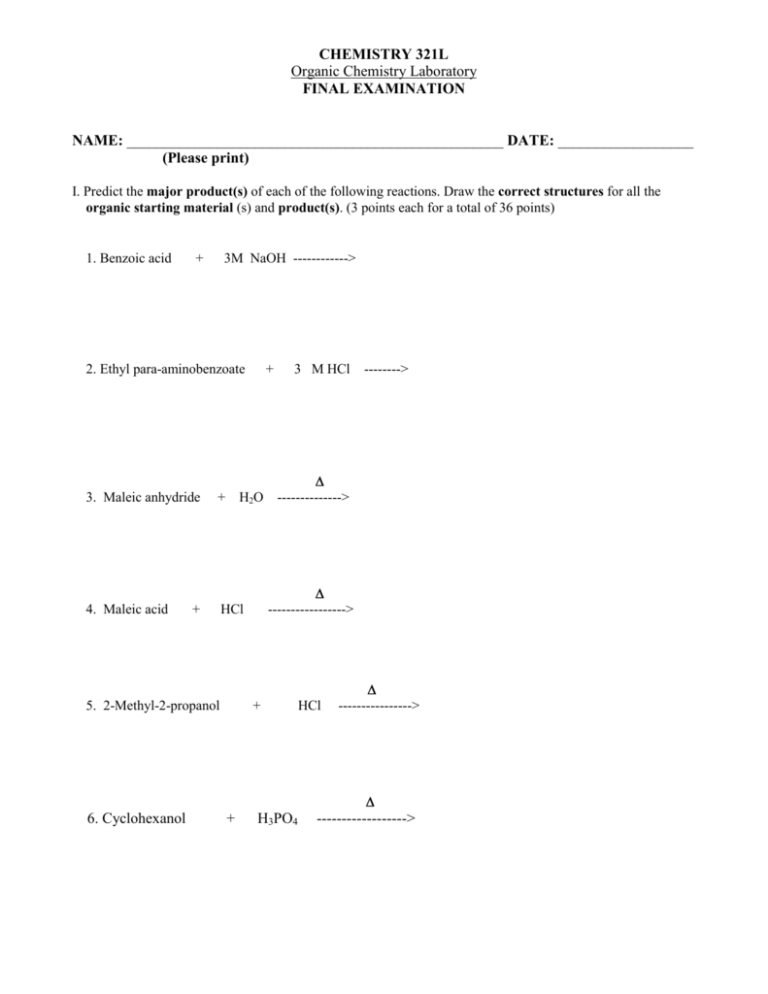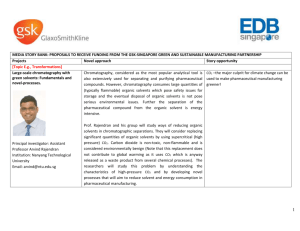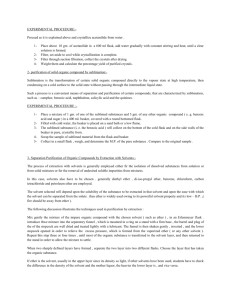CHEMISTRY 321L Organic Chemistry Laboratory FINAL
advertisement

CHEMISTRY 321L Organic Chemistry Laboratory FINAL EXAMINATION NAME: __________________________________________________ DATE: __________________ (Please print) I. Predict the major product(s) of each of the following reactions. Draw the correct structures for all the organic starting material (s) and product(s). (3 points each for a total of 36 points) 1. Benzoic acid + 3M NaOH ------------> 2. Ethyl para-aminobenzoate + 3 M HCl 3. Maleic anhydride + H2O --------------> 4. Maleic acid HCl + 5. 2-Methyl-2-propanol --------> -----------------> + HCl ----------------> 6. Cyclohexanol + H3PO4 ------------------> II. Multiple Choice: (Circle the correct answer)(42 points). 1. Hydrochloric acid, HCl, is classified as a strong acid in water. This means that it produces a) no hydrogen ions b) a relatively small fraction of the maximum number of hydrogen ions c) a relatively large fraction of the maximum number of hydrogen ions d) 100% of the maximum number of possible hydrogen ions 2. Benzoic acid is considered to be a polar molecule. Which one of the following solvents will completely dissolve benzoic acid at room temperature ? a) cyclohexane b) pentane c) 95% ethanol/H2O d) all of these solvents 3. Naphthalene, often found in moth crystals, will completely dissolve in which of the following solvents at room temperature ? (Note: toluene is methyl benzene) a) toluene b) hexane c) heptane d) all of these solvents 4. The primary reason for the addition of anhydrous magnesium sulfate to the organic solvent layer resulting from the extraction of an organic compound from water is to a) remove residual water b) remove residual NaCl c) remove residual acid catalyst d) neutralize the residual NaOH 5. Isopropyl alcohol/water (1:1) is an example of a a) polar solvent b) high boiling alkane solvent c) nonpolar solvent d) all of these 6. The hydrolysis of t-butyl chloride in aqueous 2-hydroxypropanol is an example of which of the following reaction mechanisms ? a) SN1 b) E1 c) SN2 d) E2 7. A common measure of the efficiency of a fractionating column is a) the number of components in the solution b) the number of basic types of distillation methods c) the number of theoretical plates in the column d) none of these 8. The primary reason for the addition of anhydrous magnesium sulfate to the organic solvent layer resulting from the extraction of an organic compound from water is to a) remove residual water b) remove residual NaCl c) remove residual acid catalyst d) neutralize the residual NaOH 9. Ten grams of an organic solid is dissolved in 100 ml of H2O (solvent 1). Which of the following extraction methods will remove the largest amount of the organic solid from the aqueous solution? a) three 50 ml portion extractions with ether (solvent 2) b) two 50 ml portion extractions with ether (solvent 2) c) one 150 ml portion extraction with ether (solvent 2) d) one 50 ml portion extraction with ether (solvent 2) 10. Two organic solid compounds, A and B are observed to have the same melting point. What should be done to prove that these substances are the same compound? a) b) c) d) look up the literature m.p. values of compound A and B recrystallize compound A recrystallize compound B perform a mixed melting point on a sample containing equal amounts of compounds A and B 11. Acetone is considered to be a polar molecule because a) there is a large dipole moment associated with the C=O bond b) there is a small dipole moment associated with the C=O bond c) there are very large dipole moments associated with the C-H bonds d) none of the above 12. A key step in the recrystallization process is a) dissolve the solid in a large quantity of cold solvent b) remove all of the soluble impurities by vacuum filtration c) allow the hot solution to cool slowly and precipitate the solid d) take a melting point of the wet crystals e) all of the above 13. Separation of the major pigments in a spinach extract utilized a type of chromatography called a) solid –liquid chromatography b) liquid –liquid chromatography c) gas –liquid chromatography d) none of the above 14. A sample of spinach extract was placed on a chromatographic column. What would happen if the column was eluded with acetone solvent? a) the -c a r o t e n ewou l de l udel e a v i ngt hec hl or ophy l l ’ so nt hec ol umn b) t h ec h l o r ophy l l ’ swou l de l u del e a v i ngt he-carotene on the column c) all the pigments would pass through the column and no separation of the pigments would occur d) none of the above III. 2-Methyl-2-propanol (12.7mL; d= 0.79 g/mL) was reacted with 30.0mL of concentrated hydrochloric acid. A total of 10.8 grams of pure 2-chloro-2-methylpropane was obtained from the reaction. Complete the following: (C=12, H=1, O=16, Cl=35) (12 points) (Show your work!) 1) Write the structural equation of this reaction. 2) What is the theoretical yield of this reaction? 3) What is the percent yield of this reaction? IV. Tertiary butyl chloride is hydrolyzed in the laboratory using a 1:1 mixture of isopropyl alcohol/ water. The hydrochloric acid that is produced during this solvolysis reaction is titrated with a 0.1 N standardized NaOH solution using phenophthalein as an indicator of the end point. The volumes of NaOH consumed by aliquot samples from the reaction mixture that were quenched at regular time intervals are given in the table below. Time (min.) 1.0 2.0 4.0 6.0 8.0 10.0 15.0 20.0 30.0 NaOH volume (ml.) [A] 0.3 1.0 2.6 3.2 4.8 5.6 7.4 9.2 12.8 The last 10.0ml of the reaction mixture was warmed in a 50.0 0C water bath for five minutes, cooled in ice and titrated with the 0.1 N NaOH. The volume of base consumed by this sample was 20.4 ml. and is the [A0] value. (Note: This problem is worth 20 points). 1. Tabulate the results, i.e., time, [A], as well as calculate [At], [A0], [A0]/[At], and ln [A0]/[At] on the Data Sheet below. The concentration at time t = [At] = [A0] - [A] (10 points). 2. Calculate the value of the reaction rate constant (k r ) (5 points). kr = 3. Given the equation, t1/2 = 0.693/kr , what is the half-life of the reaction (in minutes) (5 points). DATA SHEET: Solvolysis of t-butyl chloride [A0] = 20.4 mL [At] = [A0] - [A] Time (min) [A] (ml) [At] (ml [A0]/[At] ln [A0]/[At] 1 ________ _______ ________ __________ 2 ________ _______ ________ __________ 4 ________ _______ ________ __________ 6 ________ _______ ________ __________ 8 ________ _______ ________ __________ 10 ________ _______ ________ __________ 15 ________ _______ ________ __________ 20 ________ _______ ________ __________ 30 ________ _______ ________ __________







